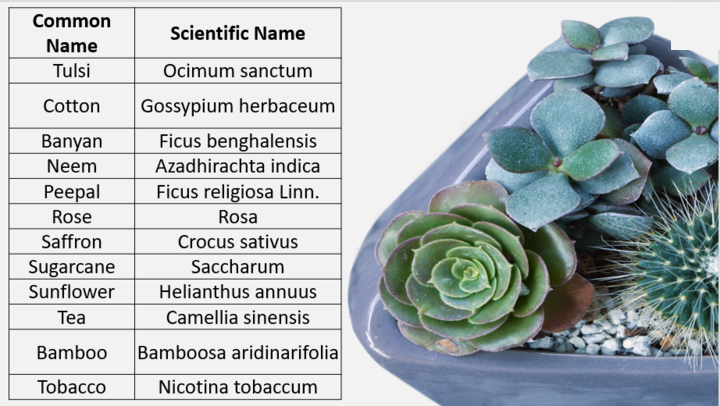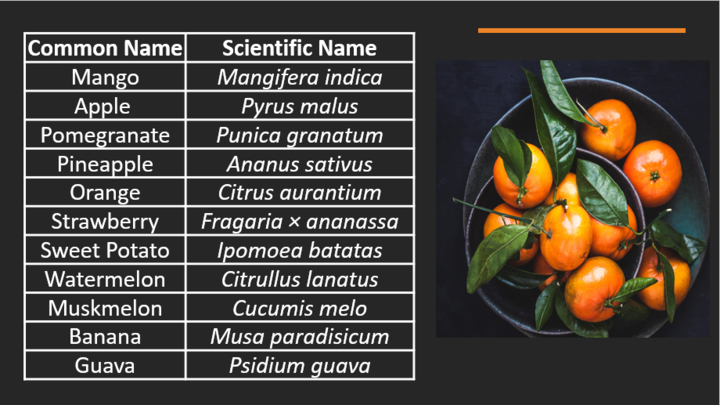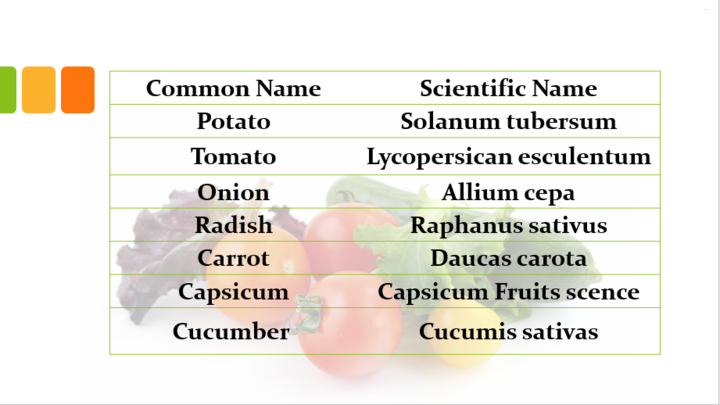- Home/
- SSC & Railways/
- RRB GROUP D/
- Article
List of Scientific Names of Fruits, Vegetables & Plants
By BYJU'S Exam Prep
Updated on: September 25th, 2023

Scientific Name of Fruits and Vegetables: Every species on earth has its own unique scientific name. If you are appearing for the upcoming competitive exams, you must go through the important scientific names of vegetables, Plants, and Fruits. To help you facilitate your preparation, we are providing study notes on Binomial Nomenclature including scientific names of fruits, vegetables, and plants.
Table of content
Binomial Nomenclature of Fruits and Vegetables
Scientific names are used to define distinct types of creatures in a universal manner so that experts from all over the world may easily recognize the same animal. This is known as binomial nomenclature, and many scientific names are taken from the organism’s Latin name.
The scientific name is divided into two parts: the genus name, which comes first, and the particular species name, which comes second.
Important |
|
Quant से लगता है डर? जानें क्या होना चाहिए Quant Preparation Strategy SSC 2023 Exams के लिए Register Now to Join Special Session By Sandeep Sir: Link to Join Click Here |
History
Carolus Linnaeus, a Swedish physician, and botanist, pioneered modern binomial nomenclature in the 18th century. The two-part name was proposed to produce a code that more easily recognized individual species without the need for extensive descriptions that might be susceptible to subjectivity.
Scientific Names of Fruits and Vegetables for SSC Exams
In the SSC exams, questions are often asked based on the scientific names of fruits, vegetables, and plants. Candidates can expect around 2-3 questions in their exam on this topic in the general awareness section. Considering the importance of the topic we are providing you with a list of scientific names of vegetables and fruits for competitive exams.
Also Read:
- Indian Cities Nicknames
- 28 states of India and their languages
- Important Days and Dates
- List of Awards and Honours with their Fields
Scientific Names of Plants
The Binomial Nomenclature is nothing but the scientific names of plants. In order to categorize plants, scientists assign each one a distinct name. This makes it simple to recognize the plants and the family to which they belong. Here is a list of all the common scientific names of plants for competitive exams. Candidates should read over the list and revise it as they prepare for the competitive government exams. They can improve their preparation by reading and memorizing the scientific names of plants.

| S. No | Common Name | Plant Scientific Name |
|---|---|---|
| 1 | Tulsi | Ocimum sanctum |
| 2 | Cotton | Gossypium herbaceum |
| 3 | Banyan | Ficus benghalensis |
| 4 | Neem | Azadhirachta indica |
| 5 | Peepal | Ficus religiosa Linn. |
| 6 | Rose | Rosa |
| 7 | Saffron | Crocus sativus |
| 8 | Sugarcane | Saccharum |
| 9 | Sunflower | Helianthus annuus |
| 10 | Tea | Camellia sinensis |
| 11 | Bamboo | Bamboosa aridinarifolia |
| 12 | Tobacco | Nicotina tobaccum |
Scientific Name of Fruits
Generally, the scientific names of fruits are derived from the Latin language. Here is a list of fruit-producing plants’ scientific names. As you know the scientific name consists of two parts: the genus name, which comes first, and the particular species name, which comes second. The table given below enlists the scientific names of fruits for competitive exams like UPSC, RRB Exam, etc.

| S. No | Common Name of Fruits | Fruits Scientific Name |
|---|---|---|
| 1 | Mango | Mangifera indica |
| 2 | Apple | Pyrus malus |
| 3 | Pomegranate | Punica granatum |
| 4 | Pineapple | Ananus sativus |
| 5 | Orange | Citrus aurantium |
| 6 | Strawberry | Fragaria × ananassa |
| 7 | Sweet Potato | Ipomoea batatas |
| 8 | Watermelon | Citrullus lanatus |
| 9 | Muskmelon | Cucumis melo |
| 10 | Banana | Musa paradisicum |
| 11 | Guava | Psidium guava |
Scientific Names of Vegetables
Given below is a list of scientific names of vegetables. Candidates must be familiar with the scientific name of vegetables and species used in India as our country is known for the species produced here. Therefore, applicants studying for competitive exams like SSC CGL, SSC CHSL, etc must understand the scientific names of vegetables, fruits, and plants. The applicants can discover the scientific names of vegetables as well as spices in the following table.

| S. No | Common Name | Scientific Name of Vegetables |
|---|---|---|
| 1 | Potato | Solanum tubersum |
| 2 | Tomato | Lycopersican esculentum |
| 3 | Onion | Allium cepa |
| 4 | Radish | Raphanus sativus |
| 5 | Carrot | Daucas carota |
| 6 | Brinjal | Solanum melongena |
| 7 | Capsicum | Capsicum Fruits scence |
| 8 | Cucumber | Cucumis sativas |
| 9 | Ginger | Zingiber officinale |
| 10 | Cauliflower | Brassica oleracea |
| 11 | Chives | Allium schoenoprasum |
| 12 | Cow pea | Vigna unguiculata |
| 13 | Coriander | Coriandrum sativum |
| 14 | Curry plant | Murraya koenigii |
| 15 | Eggplan | Solanum melongena |
| 16 | Pea | Pisum sativam |
| 17 | Lemon | Citrus Limonium |
| 18 | Jack fruit | Artocarpus integra |
| 19 | Mint (Pudina) | Mentha arvensis |
| 20 | Okra, Lady Finger | Abelmoschus esculentus |
| 21 | Pointed gourd | Trichosanthes dioica |
| 22 | Spinach | Spinacia oleracea |
| 23 | Snake gourd | Trichosanthes cucumerina |
| 24 | Lettuce | Lactuca sativa |
| 25 | Broccoli | Brassica oleracea italica group |
| 26 | Drumstick | Moringa oleifera |
| 27 | Leek | Allium porrum |
| 28 | Soybean | Glycine max |
| 29 | Common bean | Phaseolus vulgaris |
| 30 | Cassava | Manihot esculenta |
Check out:
Scientific Names of Spices
Many spices have similar or even identical common names in different regions or languages, which can lead to confusion. However, their scientific names, consisting of a genus and species, provide a unique and precise identification for each spice. Tabulated below are the scientific name of spices that are used in our daily lives.
| S. No | Common Name | Scientific Name of Spices |
|---|---|---|
| 1 | Turmeric | Curcuma longa |
| 2 | Garlic | Allium Sativum |
| 3 | Clove | Syzygium aromaticum |
| 4 | Black Pepper | Piper nigrum |
| 5 | Pea | Pisum sativam |
That’s all you need to know about the Scientific names of vegetables, fruits, plants, and spices. If you have any queries, feel free to reach out to us.


